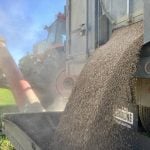Manitoba corn growers’ hopes for a lower nitrogen bill in 2022 disappeared with the N leached away by the wet spring.
Manitoba Agriculture soil specialist John Heard tested some fields in the spring and found that about 30 pounds of N per acre leached in clay soils and 80-plus pounds in sandier soils.
“We know we had a lot of carryover N from the drought but that N was predominantly in the nitrate form which is easy to lose,” Heard says. “I just hoped that corn growers would take into account that there had been losses even before they got any seed in the ground, and they couldn’t count on all that N that they had in the fall.”
Read Also

Sensing the soil: Root cell research finds ‘stress hormone’
Research into how root cells react to soil stressors could help plants better adapt to changes in their climate.
When Heard scouted 20 corn fields on sandy soils to assess their N status in mid-October 2022, it was clear that they were suffering from some N deficiency.
“We always expect the leaves to fire — turn brown or yellow — from the bottom up,” Heard said in an October 19 Crop Talk. “That’s quite normal. The plant stores N during grain fill and moves some to the kernels, so we expect to see yellowing. But work from South Dakota has shown that if the leaves within three leaves from the ear yellow, that is suggesting we ran shy on N. I am suspicious that on sandy fields we lost early-season N and that showed up later in the sea- son with some malnourished plants.”
[RELATED] A down then up year for Prairie corn
Heard said it could also be that there wasn’t enough N present in those sandier soils to meet the yield potential this season.
A post-season assessment of N sufficiency can also be done with the standard fall soil test. Recent research by the University of Manitoba’s Don Flaten has shown a post-harvest soil nitrate test in corn plots that measures less than 20 lbs. N/acre to a 24-inch soil depth suggests that the previous crop was likely deficient in N. If the soil test value is between 20 to 50 lbs. N/acre at the same depth, the previous crop was probably not excessively fertilized, and residual soil test values greater than 50 lbs. N/acre indicate that there was probably excess N available.
In-season testing
But how are corn growers to assess if their crops may need an added boost of N during the growing season? Heard said one way is with a soil test that is little-used but effective — a pre-side dress N test.
“When the corn is close to knee-high (in June) you can go in and take a one-foot-deep soil sample and there are criteria from the Midwest states and Ontario that one could use as a guide as to whether you are sufficient or insufficient in N, and when you might need to come back and put more on. If a person had maybe reduced the amount of N they put on in the spring to account for a big carryover, and then had the large amount of rain we saw this spring, they would want to use tools to reassess and see if that N is still there, so this would be the test of choice.”
Heard said there is also the question of how deep the N is and if the corn is going to reach it eventually. “We know that in dry years corn can root deeper and benefit from reserves deeper in the profile, but that probably that wasn’t the case this year because there was probably sufficient water in the upper depths so it may not have rooted as deep. But the N soil test is something growers could have used to determine that.”
Striping – S deficiency, or?
There were some signs of sulphur (S) deficiency in corn early in the growing season. Typically, plants will have strip- ing on the leaves but Heard suggests growers should con- firm the deficiency with a tissue test because other things can cause striping on corn leaves, such as zinc, iron or magnesium deficiency.
“With a zinc deficiency the stripes tend to be centred right down towards the whorl, whereas a S deficiency tends to be more full-length striping of the leaves,” Heard said. “So don’t call it visually, confirm it with a tissue test. In most cases, when we were doing that, S was the culprit which made sense based on the excessive rainfall we were having (this spring).”
Heard’s soil tests revealed that although some S was lost from the top six inches due to wet spring conditions, there was still sufficient S in the six- to 24-inch depths for the corn plants to root into.
“This deficiency was again showing up on sandier soils because sulphate can leach, but this was even where S was applied prior to seeding, so that early-season rainfall just moved it out of the rooting zone. The corn plants generally greened up as they rooted into the ample supplies in the six- to 24-inch zones.”
– This article was originally published in the January 2023 issue of the Corn Guide.
















